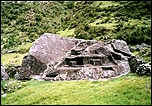Date: February 3, 2002
Great Vilcabamba Was the Capital of the Rebel Incas

Stone altar known as the Ñusta Hispana, at the entrance to Vilcabamba. (SANTIAGO DEL VALLE )
FIETTA JARQUE | Madrid
The ruins of the mythic lost city of the Incas, Great Vilcabamba, was found some 80 kilometers away in a straight line from the monumental ruins of Machu Picchu. It was identified after four expeditions headed by Galician historian Santiago del Valle. Manco Inca took shelter in this city and led a rebel movement against Spanish domination--an effort which ended in defeat.
The Ruins of Great Vilcabamba are hidden by dense vegetation and are at the summit of a mountain flanked by two large rivers some 80 Km. away from Machu Picchu, in the Peruvian department of Cusco: a nearly inaccessible location from which Manco Inca, heir to the Inca throne directed a rebellion that survived him by almost four decades. The city remained hidden in the jungle and the Spaniards were not able to reach it until 1572, when they found it burned and abandoned in the face of the onslaught.
A fair part of this story is known thanks to the discovery of a manuscript that was lost for over four centuries--the chronicle of Juan de Betanzos, found in 1987 by María del Carmen Martín Rubio in some archives on Mallorca. Betanzos was the negotiatior send by the Spaniards to deal with the rebel incas.
'We have discovered the city's location, contrasting it with the data retrieved from the chronicles and the surface area," explained Santiago del Valle, technical director of the expeditions of 1988, 1999 and 2001.
'We have been escorted by an archeaologist with the Peruvian National Institute of Culture, Luis Guevara, who certified the discovery. All we need to do know is to clean up the area, which covers some 15,000 meters approximately, and begin the exploration to which the Peruvian Government will contribute."
For the time being there aren't many traces as to what will be uncovered in this area, approximately a league and a half long and shaped like a half moon. Several intact tombs have been discovered as well as the remains of five pyramidal platforms. "It was a center of political and religious power, and although they deid their best to flee and take everything they could with them, we will surely find important remains, " says Del Valle. "I don't think it will be so spectacular in the architectural sense because they didn't have the time to perform sophisticated carving in stone. But one of the most fascinating things about the Incas was not only their buildings, but the privileged construction networks they created."
Del Valle, who belongs to an association devoited to recovering ancient roads in his native Galicia, remarks that for a civilization lacking horses and carts, the roads were built according to natural characteristics. "The structure of inca roads shows us a unique conjunction arising from their belief in spirits hidden among the rocks, the earth and certain plants and animals known as "apus" which led them to choos extraordinary, almost magical locations to place their roads." The first certain clues of the discovery were found thanks to a stone serpent and bear: "The son of the only peasant living in the area found the remains of stonework in the area which showed a large serpent's head," explains Del Valle. "These are very supersititious people and are hesitant to approach such sites. Some time afterward, the boy died and the family didn't want to hear anything more about the subject." Later on they found the tracks of a bear path. "It turned out that the bears made use of the old Inca road."
The city was forgotten until the legend was revived in the 19th century. American researcher was bent on finding it when he happend to discover the ruins of Machu Picchu.
###################
Translation (C) 2001. Scott Corrales, Institute of Hispanic Ufology.
Special Thanks to Gloria Coluchi.
Hieronimus & Co., Inc., P.O. Box 648, Owings Mills, MD 21117 USA
Voice Mail: (410) 356-4852 Fax: (410) 356-6229